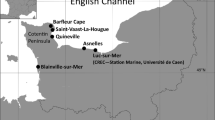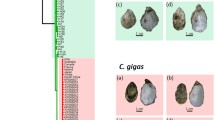Abstract
With a combination of our mitochondrial and nuclear DNA data, we evidenced the occurrence of a Crassostrea oyster hitherto unrecognized in Japan. This species, C. dianbaiensis (named Sumizome-gaki in Japanese), was very recently described as a new “tropical” oyster, although we located it in a temperate water zone (southwestern coast of Shikoku Island, Japan). Our specimens bore a morphological resemblance to the slipper cupped oyster C. bilineata (syn. C. iredalei), consistent with their close phylogenetic relationship. Some of the shell characteristics represented in the original species description were not applicable to our specimens, especially in terms of the pattern of their inner-shell coloration. Our novel finding of C. dianbaiensis in Japan updated the taxon list of Japanese Crassostrea species.







Similar content being viewed by others
References
Lam K, Morton B (2004) The oysters of Hong Kong (Bivalvia: Ostreidae and Gryphaeidae). Raffles B Zool 52:11–28
Hebert PDN, Cywinska A, Ball SL, DeWaard JR (2003) Biological identifications through DNA barcodes. Proc R Soc Lond B Biol Sci 270:313–321
Lam K, Morton B (2003) Mitochondrial DNA and morphological identification of a new species of Crassostrea (Bivalvia: Ostreidae) cultured for centuries in the Perl River delta, Hong Kong, China. Aquaculture 228:1–13
Boudry P, Heurtebise S, Lapègue S (2003) Mitochondrial and nuclear DNA sequence variation of presumed Crassostrea gigas and Crassostrea angulata specimens: a new oyster species in Hong kong? Aquaculture 228:15–25
Wu X, Xiao S, Yu Z (2013) Mitochondrial DNA and morphological identification of Crassostrea zhanjiangensis sp. nov. (Bivalvia: Ostreidae): a new species in Zhanjiang, China. Aquat Living Resour 26:273–280
Banks MA, Hedgecock D (1993) Discrimination between closely related Pacific oyster species (Crassostrea) via mitochondrial DNA sequences coding for large subunit rRNA. Mol Mar Biol Biotechnol 2:129–136
Yu Z, Kong X, Zhang L, Guo X, Xiang J (2003) Taxonomic status of four Crassostrea oysters from China as inferred from mitochondrial DNA sequences. J Shellfish Res 22:31–38
Lazoski C, Gusmão J, Boudry P, Solé-Cava AM (2011) Phylogeny and phylogeography of Atlantic oyster species: evolutionary history, limited genetic connectivity and isolation by distance. Mar Ecol Prog Ser 426:197–212
Lapègue S, Batista FM, Heurtebise S, Yu Z, Boudry P (2004) Evidence for the presence of the Portuguese oyster, Crassostrea angulata, in northern China. J Shellfish Res 23:759–763
Melo CMR, Silva FC, Gomes CHAM, Solè-Cava AM, Lazoski C (2010) Crassostrea gigas in natural oyster banks in southern Brazil. Biol Invasions 12:441–449
Hong J-S, Sekino M, Sato S (2012) Molecular species diagnosis confirmed the occurrence of Kumamoto oyster Crassostrea sikamea in Korean waters. Fish Sci 78:259–267
Sekino M, Yamashita H (2013) Mitochondrial DNA barcoding for Okinawan oysters: a cryptic population of the Portuguese oyster Crassostrea angulata in Japanese waters. Fish Sci 79:61–76
Harry HW (1985) Synopsis of the supra specific classification of living oysters (Bivalvia: Gryphaeidae and Ostreidae). Veliger 28:121–158
Inaba A, Torigoe K (2004) Oysters in the world, Part 2: systematic description of the recent oysters. Bull Nishinomiya Shell Mus 3 (in Japanese)
Huber M (2010) Compendium of bivalves. ConchBooks, Hackenheim
Okutani T (2000) Marine mollusks in Japan. Tokai University Press, Kanagawa (in Japanese)
Xia J, Yu Z (2009) Identification of seven Crassostrea oysters from the South China Sea using PCR–RFLP analysis. J Molluscan Stud 75:139–146
Liu J, Li Q, Kong L, Yu H, Zheng X (2011) Identifying the true oysters (Bivalvia: Ostreidae) with mitochondrial phylogeny and distance-based DNA barcoding. Mol Ecol Resour 11:820–830
Xia J, Wu X, Xiao S, Yu Z (2014) Mitochondrial DNA and morphological identification of a newcupped oyster species Crassostrea dianbaiensis (Bivalvia:Ostreidae) in the South China Sea. Aquat Living Resour 27:41–48
Folmer O, Black M, Hoeh W, Lutz R, Vrijenhoek R (1994) DNA primers for amplification of mitochondrial cytochrome c oxidase subunit I from diverse metazoan invertebrate. Mol Mar Biol Biotechnol 3:294–299
Don RH, Cox PT, Wainwright BJ, Baker K, Mattick JS (1991) ‘Touchdown’ PCR to circumvent spurious priming during gene amplification. Nucleic Acids Res 19:4008
Sekino M, Sato S, Hong J-S, Li Q (2012) Contrasting pattern of mitochondrial population diversity between an estuarine bivalve, the Kumamoto oyster Crassostrea sikamea, and the closely related Pacific oyster C. gigas. Mar Biol 159:2757–2776
Wu X, Li X, Li L, Xu X, Xia J, Yu Z (2012) New features of Asian Crassostrea oyster mitochondrial genomes: A novel alloacceptor tRNA gene recruitment and two novel ORFs. Gene 507:112–118
Hedgecock D, Li G, Banks MA, Kain Z (1999) Occurrence of the Kumamoto oyster Crassostrea sikamea in the Ariake Sea, Japan. Mar Biol 133:65–68
Thompson JD, Higgins DG, Gibson TJ (1994) CLUSTAL W: improving the sensitivity of progressive multiple sequence alignment through sequence weighting, position-specific gap penalties and weight matrix choice. Nucleic Acids Res 22:4673–4680
Tamura K, Peterson D, Peterson N, Stecher G, Nei M, Kumar S (2011) MEGA5: molecular evolutionary genetics analysis using maximum likelihood, evolutionary distance, and maximum parsimony method. Mol Biol Evol 28:2731–2739
Fitch WM (1977) On the problem of discovering the most parsimonious tree. Am Nat 111:223–257
Saitou N, Nei M (1987) The neighbor-joining method:a new method for reconstructing phylogenetic trees. Mol Biol Evol 4:406–425
Nei M, Kumar S (2000) Molecular evolution and phylogenetics. Oxford University Press, NY
Kimura M (1980) A simple method for estimating evolutionary rate of base substitutions through comparative studies of nucleotide sequences. J Mol Evol 16:111–220
Wang H, Guo X, Zhang G, Zhang F (2004) Classification of Jinjiang oysters Crassostrea rivularis (Gould, 1861) from China, based on morphology and phylogenetic analysis. Aquaculture 242:137–155
Álvarez I, Wendel JF (2003) Ribosomal ITS sequences and phylogenetic inference. Mol Phyl Evol 29:417–434
Foighil DÓ, Gaffney PM, Wilbur AE, Hilbish TJ (1998) Mitochondrial cytochrome oxidase I gene sequences support an Asian origin for the Portuguese oyster Crassostrea angulata. Mar Biol 131:497–503
Reece KS, Cordes JF, Stubbs JB, Hudson KL, Francis EA (2008) Molecular phylogenies help resolve taxonomic confusion with Asian Crassostrea oyster species. Mar Biol 153:709–721
Melo AGC, Varela ES, Beasley CR, Schneider H, Sampaio I, Gaffney PM, Reece KS, Tagliaro CH (2010) Molecular identification, phylogeny and geographic distribution of Brazilian mangrove oysters (Crassostrea). Genet Mol Biol 33:564–572
Nei M (1987) Molecular evolutionary genetics. Columbia Univrsity Press, NY
Librado P, Rozas J (2009) DnaSP v5: a software for comprehensive analysis of DNA polymorphism data. Bioinformatics 25:1451–1452
Stenzel HB (1971) Oysters. In: Moore RC (ed) Treatise on invertebrate paleontology, Part N, vol 3., Mollusca 6Bivalvia. Geological Society of America and Universityof Kansas Press, Kansas, pp N953–N1224
Ohlberger J, Brännström Å, Dieckmann U (2013) Adaptive phenotypic diversification along a temperature-depth gradient. Am Nat 183:359–373
Habe T (1977) Taxonomy of Japanese Mollusks: Bivalvia and Scaphopoda. Hokuryukan, Tokyo (in Japanese)
Kubo H, Kurozumi T (1995) Marine and terrestrial mollusks in Okinawa. Okinawa Syuppan, Okinawa (in Japanese)
Higo S, Callomon P, Goto Y (1999) Catalogue and bibliographyof the marine shell-bearing Mollusca of Japan: Gastropoda, Bivalvia, Polyplacophora. Scaphopoda, Elle Scientific, Osaka
Nawa J (2009) Molluscan fauna of tidal flats in the Ryukyu Islands, Part 2: Okinawa, Miyako and Yaeyama Islands. Bull Nishinomiya Shell Mus 6. (in Japanese)
Wang H, Qian L, Liu X, Zhang G, Guo X (2010) Classification of a common cupped oyster from Southern China. J Shellfish Res 29:857–866
Carlton JT (1985) Transoceanic and interoceanic dispersal of coastal marine organisms: the biology of ballast water. Oceanogr Mar Biol Annu Rev 23:313–371
Leung KMY, Dudgeon D (2008) Ecological risk assessment and management of exotic organisms associated with aquaculture activities. In: Bondad-Reantaso MGet al. (eds.) Understanding and Applying Risk Analysis in Aquaculture. FAO, Rome. pp 67–100
Bussarawit S, Cedhagen T, Shirayama Y, Torigoe K (2010) Field Guide to the Oyster Fauna of Thailand. Kyoto University Press, Kyoto
Luikart G, England PR, Tallmon D, Jordan S, Taberlet P (2003) The power and promise of population genomics: from genotyping to genome typing. Nat Rev Genet 4:981–994
Wu X, Xu X, Yu Z, Wei Z, Xia J (2010) Comparison of seven Crassostrea mitogenomes and phylogenetic analyses. Mol Phylogenet Evol 57:448–454
Ren J, Liu X, Zhang G, Liu B, Guo X (2009) ‘Tandem duplication-random loss’ is not a real feature of oyster mitochondrial genomes. BMC Genom 10:84
Yu H, Li Q (2011) Mutation and selection on the wobble nucleotide in tRNA anticodons in marine bivalve mitochondrial genomes. PLoS ONE 6:e16147
Varela ES, Beasley CR, Schneider H, Sampaio I, Marques-Silva NDS, Tagliaro CH (2007) Molecular phylogeny of mangrove oysters (Crassostrea) from Brazil. J Molluscan Stud 73:229–234
Galvão MS, Pereira OM, Hilsdorf AWS (2013) Molecular identification and distribution of mangrove oysters (Crassostrea) in an estuarine ecosystem in Southeast Brazil: implications for aquaculture and fisheries management. Aquacult Res 44:1589–1601
Milbury CA, Gaffney PM (2005) Complete mitochondrial DNA sequence of the eastern oyster Crassostrea virginica. Mar Biotechnol 7:697–712
Acknowledgments
We express our gratitude to Drs. Takenori Sasaki and Yasuhiro Ito, the University Museum, the University of Tokyo, for their assistance in conserving our specimens (shells) at UMUT. We thank two anonymous reviewers and the subject editor for their suggestions and recommendations to improve the manuscript.
Author information
Authors and Affiliations
Corresponding author
Electronic supplementary material
Below is the link to the electronic supplementary material.
Rights and permissions
About this article
Cite this article
Sekino, M., Ishikawa, H., Fujiwara, A. et al. The first record of a cupped oyster species Crassostrea dianbaiensis in the waters of Japan. Fish Sci 81, 267–281 (2015). https://doi.org/10.1007/s12562-014-0838-3
Received:
Accepted:
Published:
Issue Date:
DOI: https://doi.org/10.1007/s12562-014-0838-3




